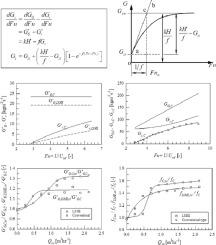International Journal of Heat and Mass Transfer ( IF 5.0 ) Pub Date : 2021-06-14 , DOI: 10.1016/j.ijheatmasstransfer.2021.121541 Anusorn Chinsuwan

|
A mathematical model for predicting the flow behavior through a conventional U type loop-seal was developed by considering the loop-seal as a lumped system. The change rate of the gross forward particle flow rate () with respect to the fluidization number at its bottom (), , is assumed to be a function of the products of the gross forward particle flow rate coefficient () and the differential head across it. In addition, the flow resistance is considered as the virtual backward particle flow rate (). Its change rate () is assumed to be a function of the products of the virtual backward flow coefficient () and the solid circulation rate provided by the loop-seal (). The effects of the side aeration at the recycle side walls and heat exchanger in the chamber on the performance of the loop-seal was investigated. It was found that the relation between and is an asymptotic or a saturated function. From the regression analysis of the experimental data from a cold model circulating fluidized bed system according to the function, the function constants are obtained with the coefficient of determination of not less than 0.97. is constant, while increases with . The loop-seal with heat exchanger (LSHE) has a lower . The LSHE with side aeration has a change rate of the forward particle flow rate with respect to , and the virtual backward flow coefficient higher than the conventional loop-seal for the side aeration flow rate less than a certain value. After that, the opposite trend was found. The loop-seal having a higher will have a lower or side aeration flow rate corresponding to saturated . The developed model may be applied to any types and sizes of loop-seal and suggests that in order to have a high , loop-seals should have their configuration provide a high gross forward particle flow rate coefficient () and a low virtual backward flow coefficient ().
中文翻译:

用于预测通过 CFB 反应器 U 型回路 - 密封件的流动行为的数学模型
通过将回路密封视为集总系统,开发了用于预测通过常规 U 型回路密封的流动行为的数学模型。总前向粒子流量变化率() 相对于其底部的流化数 (), , 被假定为总前向粒子流速系数 () 和穿过它的差动头。此外,流动阻力被认为是虚拟的反向粒子流量()。其变化率() 被假定为虚拟逆流系数 () 和循环密封提供的固体循环速率 ()。研究了循环侧壁处的侧向曝气和室中的热交换器对环路密封性能的影响。发现之间的关系 和 是渐近或饱和函数。根据函数对冷模循环流化床系统的实验数据进行回归分析,得到确定系数不小于0.97的函数常数。 是常数,而 增加 . 带热交换器的回路密封 (LSHE) 具有较低的. 带有侧向曝气的 LSHE 具有相对于前向颗粒流速的变化率,且侧曝气流量小于一定值时,虚拟倒流系数高于常规环封。之后,发现了相反的趋势。环封具有较高的会有更低的 或与饱和对应的侧曝气流量 . 开发的模型可应用于任何类型和尺寸的环封,并建议为了获得高,环路密封件的配置应提供高总前向颗粒流速系数() 和低虚拟回流系数 ()。











































 京公网安备 11010802027423号
京公网安备 11010802027423号